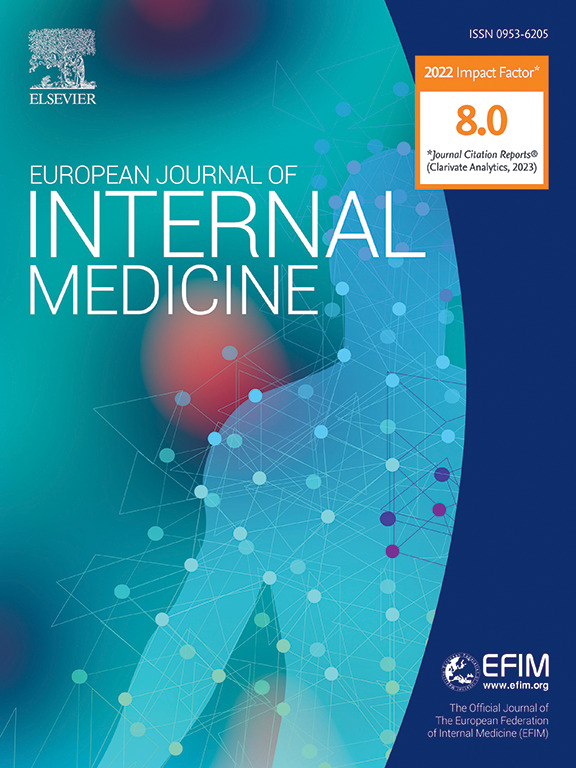比较用于预测老年高血压门诊患者功能衰退的不同虚弱工具(HYPER-FRAIL 试验研究 2)。
IF 5.9
2区 医学
Q1 MEDICINE, GENERAL & INTERNAL
引用次数: 0
摘要
背景和目的:很少有研究对老年高血压患者的虚弱状况进行评估,而且识别该人群虚弱状况的最合适工具也尚未确定。本研究比较了六种虚弱工具在预测老年高血压门诊患者 1 年功能衰退方面的表现:这项纵向试点研究涉及意大利佛罗伦萨卡雷吉医院(Careggi Hospital)两个老年门诊中年龄≥75 岁的高血压患者,他们接受了四种虚弱量表(弗里德虚弱表型、虚弱指数[FI]、临床虚弱量表[CFS]、虚弱邮政评分)和两种体能测试(短期体能测试[SPPB]和步速)的虚弱鉴定。根据 ROC 曲线分析和多变量逻辑回归对 1 年功能衰退(即从基线到随访期间 Barthel 指数下降≥ 10 分)进行了预测:结果:116 名参与者中有 24% 报告功能下降。在 ROC 曲线分析中,FI(AUC=0.76)、CFS(AUC=0.77)、步速(AUC=0.73)和 SPPB(AUC=0.77)的预测效果最好,其中 FI ≥0.21 和 CFS ≥4 的灵敏度(82%)和阴性预测值(91%)最高。通过FI、CFS或体能测试确定的虚弱与1年功能衰退的风险增加有关,与基线功能状态和合并症负担无关:FI、CFS和体能测试对高血压门诊患者功能衰退的预测能力相似。CFS和步速可能更适合临床使用,可用于识别功能衰退风险较低的非体弱者。本文章由计算机程序翻译,如有差异,请以英文原文为准。
Comparison of different frailty instruments for prediction of functional decline in older hypertensive outpatients (HYPER-FRAIL pilot study 2)
Background and aims
Few studies have evaluated frailty in older hypertensive individuals and the most appropriate tools to identify frailty in this population have yet to be identified. This study compared the performance of six frailty instruments in the prediction of 1-year functional decline in older hypertensive outpatients.
Methods
The HYPERtension and FRAILty in Older Adults (HYPER-FRAIL) longitudinal pilot study involved hypertensive participants ≥75 years from two geriatric outpatient clinics at Careggi Hospital, Florence, Italy, undergoing identification of frailty with four frailty scales (Fried Frailty Phenotype, Frailty Index [FI], Clinical Frailty Scale [CFS], Frailty Postal Score) and two physical performance tests (Short Physical Performance Battery [SPPB] and gait speed). Prediction of 1-year functional decline (i.e. a ≥ 10-point Barthel Index decrease between baseline and follow-up) was examined based on ROC curve analysis and multivariable logistic regression.
Results
Among 116 participants, 24 % reported functional decline. In the ROC curve analyses, FI (AUC=0.76), CFS (AUC=0.77), gait speed (AUC=0.73) and the SPPB (AUC=0.77) achieved the best predictive performance, with FI ≥0.21 and CFS ≥4 showing the highest sensitivity (82 %) and negative predictive value (91 %). Frailty identified with FI, CFS or physical performance tests was associated with an increased risk of 1-year functional decline, independently of baseline functional status and comorbidity burden.
Conclusions
FI, CFS and physical performance tests showed similar predictive ability for functional decline in hypertensive outpatients. The CFS and gait speed might be more suitable for clinical use and may be useful to identify non-frail individuals at lower risk of functional decline.
求助全文
通过发布文献求助,成功后即可免费获取论文全文。
去求助
来源期刊
CiteScore
9.60
自引率
6.20%
发文量
364
审稿时长
20 days
期刊介绍:
The European Journal of Internal Medicine serves as the official journal of the European Federation of Internal Medicine and is the primary scientific reference for European academic and non-academic internists. It is dedicated to advancing science and practice in internal medicine across Europe. The journal publishes original articles, editorials, reviews, internal medicine flashcards, and other relevant information in the field. Both translational medicine and clinical studies are emphasized. EJIM aspires to be a leading platform for excellent clinical studies, with a focus on enhancing the quality of healthcare in European hospitals.

 求助内容:
求助内容: 应助结果提醒方式:
应助结果提醒方式:


